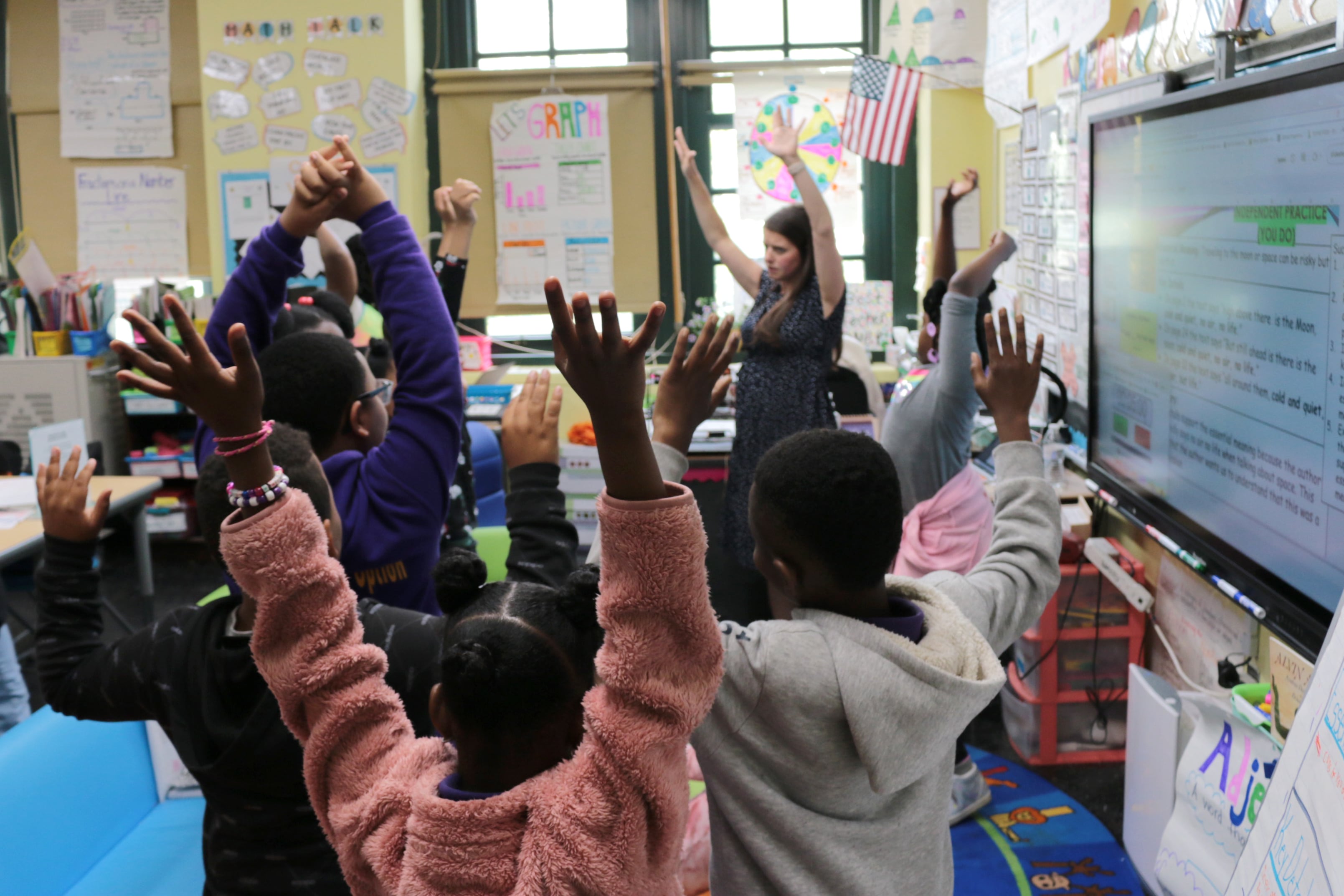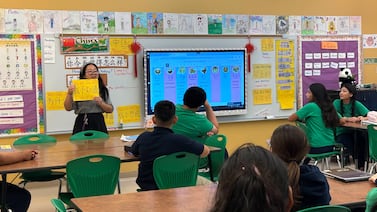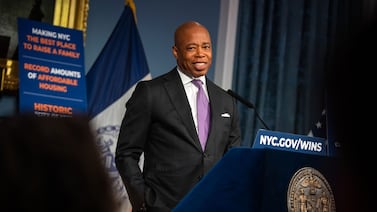New York City’s Education Department won’t see another round of city budget cuts this spring, Mayor Eric Adams announced Wednesday.
But the school system still stands to lose hundreds of millions of dollars of expiring federal aid by this summer unless city and state officials act quickly to replace it, advocates warned.
Adams said he will not move forward with a third round of planned budget cuts to city agencies, citing better-than-anticipated revenue and shrinking spending on migrants. The previous two rounds of cuts slashed a total of more than $700 million from the Education Department’s budget for next fiscal year.
Advocates celebrated Wednesday’s news, but warned it does nothing to reverse the massive cuts already coming through previous reductions in city spending and the approaching fiscal cliff of expiring federal aid.
“We are relieved that there is not going to be another round of cuts to the New York City Department of Education,” said Randi Levine, the policy director of Advocates for Children of New York. “But we are deeply concerned about the cuts that are currently being proposed. We need the city to make a substantial investment … to ensure that we don’t have devastating cuts to education programs come July.”
Among the programs that could be partially or fully eliminated when the federal money runs out: 450 new social workers, whose salaries are covered by the one-time federal aid; the city’s recently expanded free preschool program for 3-year-olds; and more than 100 “community schools” that partner with community organizations to provide extra support to families. Funding that propped up the budgets of schools whose enrollment fell during the pandemic is also drying up.
Advocates for Children is one member of the recently formed Emergency Coalition to Save Education Programs, which is calling on the city and state to come up with more than $1 billion dollars in this year’s budget to replace the expiring federal aid.
One hundred and sixty community groups signed onto a letter last September sounding the alarm about the fiscal cliff. There was some movement in January, when Adams announced $80 million in city funding this summer to help continue Summer Rising, the academic and recreational summer program that began during the pandemic.
But advocates say that’s only the tip of the iceberg – and worry that the urgency of the situation hasn’t yet sunk in for city and state officials.
In fact, at the January briefing announcing the Summer Rising funding, Adams said he “had no clue of the extent of how many programs were being funded by stimulus dollars” until schools Chancellor David Banks had briefed him earlier that month.
Here are some of the biggest programs currently funded by federal aid, and a glimpse at what could happen if the money runs out without a replacement:
Social workers and school psychologists on the chopping block
The salaries of 450 social workers and 60 psychologists were covered by nearly $80 million in relief money this year as part of a pandemic effort to bring mental health support to schools without full-time help.
The influx brought social workers to roughly 194,000 students who previously didn’t have a full-time social worker in their school, advocates estimate. If schools lose the federal money funding these positions, they’ll either have to scrounge up money from elsewhere in their budgets – an unlikely prospect with school budgets poised to shrink next year – or “excess” them, sending them to a central pool where they’d have to wait to get picked up by a new school.
One Brooklyn principal who hired a full-time social worker for the first time with the pandemic aid said it’s made an “enormous” difference to have a staff member who can focus on behavioral issues, freeing up other administrators to focus on academic needs.
“I’m very worried about what will happen if we lose her,” said the principal, who spoke on the condition of anonymity. “There is no way I can keep her unless the funds are replaced.”
Education Department spokesperson Jenna Lyle said the agency is “extremely grateful” for the relief money and is “working with the administration to identify new funding sources.” The department will “provide guidance to schools so they can appropriately plan for the upcoming school year,” she added.
$160 million to prop up school budgets amid enrollment losses
During the pandemic, former Mayor Bill de Blasio’s administration paused the normal process of slashing school budgets when enrollment fell, and instead spent $375 million in federal aid to keep school budgets steady, even as enrollment cratered.
Adams began tapering off that support in 2022, cutting $215 million from the “hold harmless” pot, which left it at $160 million. That $160 million will disappear next year unless city and state officials replace it – and it will come directly out of the budgets schools use to pay for staff and supplies. If a school’s enrollment increases next year, the accompanying budget bump might offset some of that loss. But if their enrollment shrinks or stays steady, they’ll feel the full effects.
An expanded preschool program
De Blasio used federal relief money to advance a long-standing goal of expanding the city’s free preschool program for 3-year-olds in the same way he built out the city’s heralded universal prekindergarten program for 4-year-olds.
The 3-K expansion has been rockier, with more empty seats – but it’s still brought free preschool to more than 20,000 new 3-year-olds since the start of the pandemic.
If the city’s current proposed budget passes unchanged, spending on the 3-K and pre-K programs will fall by $263 million next year, according to advocates’ budget analysis. About $170 million of those cuts come from the city’s own budget trims, which officials have said will only affect seats that aren’t currently filled.
But there’s also $93 million in federal aid for 3-K that could disappear next year. The city’s cuts alone could reduce the number of 3-K seats by between 9,000 and 15,000, according to projections from the Citizens’ Committee for Children. Even if the seats that get cut were empty, losing so much funding could make it impossible for some providers to keep their lights on at all, said Jennifer March, the Executive Director of the Citizens’ Committee for Children.
“It could have a detrimental impact on the fiscal viability of that provider long term,” she said.
The clock is ticking for other programs
There are many other critical programs paid for with federal aid, including 100 staff members working directly in homeless shelters to help students with transportation and other needs, and more than 100 new community schools that partner with nonprofits to provide social services and extra support to families. A recent effort to reduce the long-standing shortage of preschool special education seats is also in jeopardy.
There’s also precious little time for city and state officials to salvage those programs. The state’s budget deadline is April 1. Advocates say things are moving the wrong direction so far: A revision to the state’s funding formula is leaving the city Education Department with $130 million less than expected.
The city’s budget deadline is further out in June. But there’s a perhaps even steeper climb to reverse some of the $700 million in cuts Adams has proposed in recent months – while also coming up with new money to replace the sunsetting federal aid.
But advocates said the stakes are too high for lawmakers not to act.
“We are talking to everyone at both the city and state levels,” said Levine. “A parent who doesn’t have access to 3-K doesn’t care if they lost the seat because of federal, state, city funding … they care that they’re losing that seat.”
Michael Elsen-Rooney is a reporter for Chalkbeat New York, covering NYC public schools. Contact Michael at melsen-rooney@chalkbeat.org.






